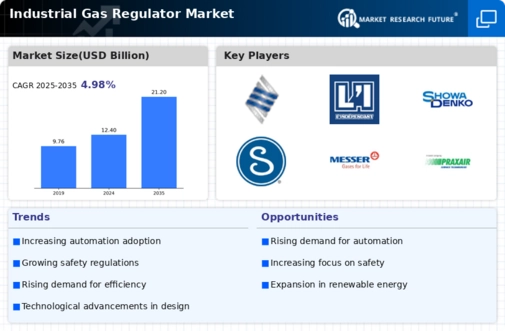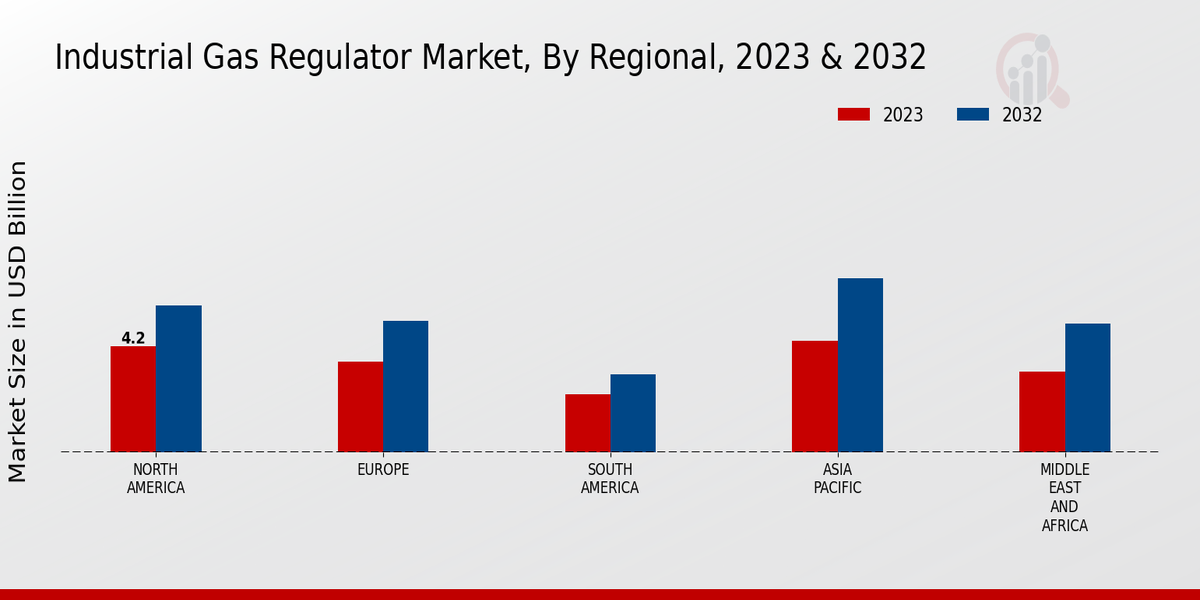Market Growth Projections
The Global Industrial Gas Regulator Market Industry is poised for substantial growth, with projections indicating a market size of 12.4 USD Billion in 2024 and an anticipated increase to 21.2 USD Billion by 2035. This growth trajectory suggests a compound annual growth rate (CAGR) of 4.98% from 2025 to 2035. The increasing demand for industrial gases, coupled with advancements in regulator technology and stringent safety regulations, is expected to drive this expansion. As industries continue to evolve and diversify, the need for reliable and efficient gas regulation solutions will likely remain a priority, further propelling the market forward.
Rising Focus on Energy Efficiency
The Global Industrial Gas Regulator Market Industry is witnessing a rising focus on energy efficiency as industries seek to reduce operational costs and environmental impact. Gas regulators play a crucial role in optimizing gas usage, thereby enhancing energy efficiency in various applications. Industries are increasingly adopting advanced regulators that minimize gas wastage and ensure precise flow control. This trend is particularly evident in sectors such as manufacturing and energy, where efficient gas management can lead to substantial cost savings. As the market evolves, the emphasis on energy-efficient solutions is likely to drive demand for innovative gas regulators, contributing to the projected growth of the industry.
Growing Demand for Industrial Gases
The Global Industrial Gas Regulator Market Industry is experiencing a notable surge in demand for industrial gases across various sectors, including healthcare, manufacturing, and energy. This demand is primarily driven by the increasing utilization of gases such as oxygen, nitrogen, and argon in diverse applications. For instance, the healthcare sector relies heavily on oxygen regulators for patient care, while the manufacturing industry employs nitrogen for inerting processes. As the global market for industrial gases is projected to reach 12.4 USD Billion in 2024, the need for reliable gas regulators becomes paramount to ensure safety and efficiency in gas delivery systems.
Expansion of Industrial Applications
The expansion of industrial applications for gas regulators is a key driver of the Global Industrial Gas Regulator Market Industry. Industries such as food and beverage, pharmaceuticals, and metal fabrication are increasingly utilizing gas regulators for various processes, including packaging, sterilization, and welding. This diversification in applications is fostering a broader market for gas regulators, as each sector requires specific types of regulators tailored to their unique needs. The growth in these sectors is expected to contribute to the overall market expansion, with projections indicating a market size of 21.2 USD Billion by 2035, reflecting the increasing reliance on gas regulators in diverse industrial processes.
Regulatory Compliance and Safety Standards
The Global Industrial Gas Regulator Market Industry is heavily influenced by stringent regulatory compliance and safety standards imposed by governmental bodies. These regulations are designed to ensure the safe handling and usage of industrial gases, necessitating the adoption of high-quality gas regulators. Industries are compelled to invest in reliable regulators that meet these safety standards, thereby driving market growth. As companies strive to comply with regulations, the demand for certified gas regulators is likely to increase, contributing to the anticipated CAGR of 4.98% from 2025 to 2035. This trend underscores the importance of safety in gas management across various sectors.
Technological Advancements in Regulator Design
Innovations in the design and functionality of gas regulators are significantly influencing the Global Industrial Gas Regulator Market Industry. Advanced materials and technologies are being integrated into regulator designs to enhance performance, safety, and durability. For example, the introduction of smart regulators equipped with IoT capabilities allows for real-time monitoring and control of gas flow, thereby improving operational efficiency. These advancements not only cater to the evolving needs of industries but also align with the projected market growth, which is expected to reach 21.2 USD Billion by 2035, indicating a robust demand for technologically advanced gas regulation solutions.











